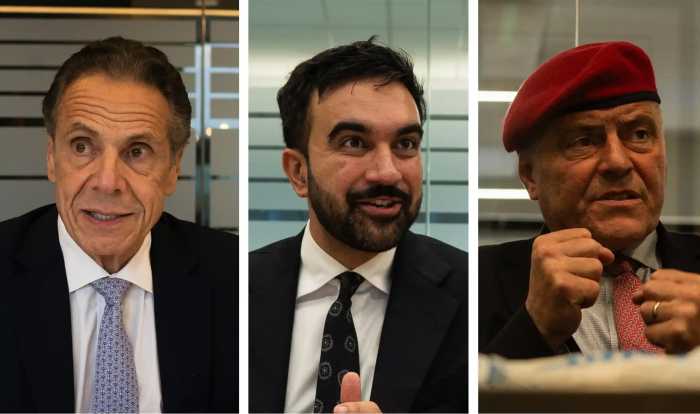Groundbreaking study deciphers census data to determine a heretofore invisible number
On January 11, a groundbreaking panel at the Lesbian, Gay, Bisexual and Transgender Community Center discussed the release of a new study on the presence of Asian and Pacific Islander same-sex households in the New York area. The evening was part of the Center’s “Second Tuesdays” lecture series.
Up to now, little has been known about the characteristics of homes headed by gay people of Asian descent. The study by The Asian American Federation of New York (AAFNY), made use of data compiled in the 2000 U.S. Census to highlight Asian same-sex households in New York, Los Angeles and San Francisco—which together comprised nearly half of the nationwide Asian gay and lesbian household population in 2000—and compared them with Asian heterosexual households as well as to non-Asian gay and lesbian households.
Panelists last Tuesday included Alain Dang, a policy analyst for the National Gay and Lesbian Task Force Policy Institute, Nancy Yu, a researcher for the Asian American Legal Defense and Education Fund (AALDEF) and Glenn D. Magpantay, an AALDEF staff attorney and co-chair of Gay Asian & Pacific Islander Men of New York (GAPIMNY).
Dang and Yu began with a slide-show presentation outlining the results of the study that focused on “Asian households,” a term which refers to domestic units in which the head-of-household identified him/herself as Asian, Native Hawaiian or Other Pacific Islander (NHOPI), and also described another same-sex member of the household as an “unmarried partner” – the only option currently available to partners of LGBT people on the U.S. Census form. Based on these criteria, the study identified 17,163 Asian and 2,050 NHOPI same-sex households nationwide. However, panelists were quick to point out that LGBT individuals of all races are grossly undercounted as a general rule, due to the fixed nature of options available to answer census questions, as well as to the continuing stigma against LGBT people.
“There has been a kind of fear amongst LGBT people to document the existence of same-sex households,” remarked Magpantay, offering one possible explanation for the low number of Asian same-sex households counted. “After all, the last time this was done was really Nazi Germany.” However, Magpantay also blamed politics in making it purposely difficult to count LGBT people. “It’s very political – if the census concludes that there aren’t that many gay people in Iowa, [politicians] don’t have to deal with gay rights there,” said Magpantay. “We’re very aware that [the information we’ve gathered for this study] can also be used against us,” he continued, acknowledging that 17,163 households is not that large a number. “Our opposition can say, ‘Why bother?’ We have to be very careful about how it is presented.”
“It’s extremely problematic, the way they’re counting,” added Nancy Yu, when one audience member voiced his concern during the open discussion period that only same-sex households “headed” by Asians were being counted. Alain Dang spoke about the struggles involved with reforming census questions to accurately reflect the existence of certain groups. “The census form is very fixed in terms of how long the government wants it to be. They’re very hesitant to add or change questions, although groups do advocate for it all the time,” said Dang.
Magpantay also called attention to the fact that the current census format—and thus, the AAFNY study—does not allow for any representation of queer Asian young people, transgender people or bisexuals currently living with opposite-sex partners.
Cao K. O, executive director of AAFNY, recently commented on the study during a briefing in New York. “This census report offers important insight on the Asian/ Pacific-American gay and lesbian population, which has received little research attention,” remarked O. “We are sharing our findings to provide a foundation for community service planning, public discussion and comprehensive research, in line with our broader goal of expanding understanding of Asian-American population characteristics,” he continued. O also stressed the study’s revelation of “a distinct set of demographic features that differentiate Asian American same-sex household residents from individuals living in non-Asian gay and lesbian households,” the major characteristics being “lower income, less English ability, less education, higher percentages of immigrants, and a greater presence of children in the home.”
In New York City, for example, the median income for Asian gay and lesbian households was $55,500 a year, compared with $69,300 for non-Asian same-sex households, while 16 percent of Asian same-sex households reported that they spoke English “not well” or “not at all,” compared to just 7 percent of non-Asian same-sex couples. In the New York metropolitan area 2,653 Asian same-sex households were counted, representing the highest number in the nation.
Equally disquieting were statistics that compared the economic status of Asian gay couples to their lesbian counterparts. Within the New York City Asian same-sex population, for example, the median income for gay couples was $60,000, compared to just $42,000 for lesbian couples. The widest variation occurred in Los Angeles, where the median income for male households was $81,000—56 percent more than the $51,900 median income for female households. Also, in New York City, the number of Asian lesbian low-income households (less than $25,000 annually) was more than double that of Asian gay low-income households.
One attendee of Tuesday’s event suggested that Asian/ Pacific-Americans become more active in the LGBT community’s advocacy groups and more involved with policy issues. “We are less visible and we have more baggage [than non-Asian LGBT people]. We need to demand more and come out more,” remarked the audience member.
Magpantay concluded the panel discussion by inviting the LGBT Community Center staff and attendees of the event to continue the conversation by developing ways to reach out to the Asian/Pacific-American same-sex community. “The work is far from done,” said Magpantay, referring to the AAFNY study. “[We] represent a population that is greatly underserved and overlooked.”
The full AAFNY study is available online at www.aafny.org/cic.
For more information and resources for Asian/Pacific-American LGBT individuals, please visit: gapimny.org, q-wave.org and aaldef.org.
gaycitynews.com




































